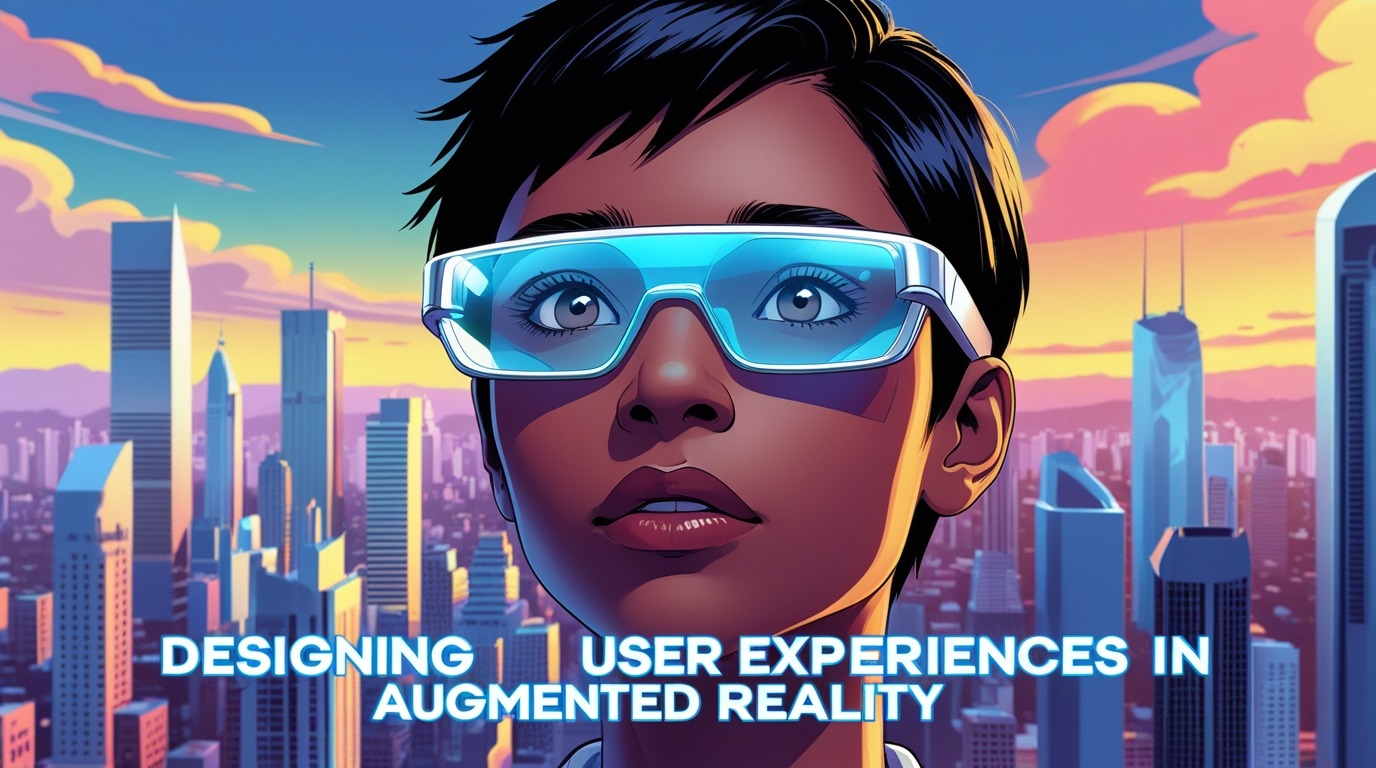Designing User Experiences in Augmented Reality: Principles, Best Practices, and Future Trends
Introduction
Imagine walking into a furniture store, pointing your phone at an empty corner of your living room, and instantly seeing how a sofa looks in real size and color. Or think about wearing AR glasses in a factory, where step-by-step visual guides appear in your view to help you fix machinery in real time.
These experiences are possible because of Augmented Reality (AR) — a technology that overlays digital content onto the physical world, creating an immersive blend of virtual and real environments.
But here’s the catch: AR succeeds or fails on the quality of its user experience (UX). A poorly designed AR interface feels clunky, confusing, or distracting, while a thoughtful design can make AR seamless, intuitive, and delightful.
As AR continues to expand into industries like healthcare, education, retail, and entertainment, designing user-centric experiences has never been more critical. This blog explores the principles, best practices, and future trends for creating engaging, safe, and effective AR user experiences.
1. Contextual Relevance
One of the most important rules of AR design is to make sure the content is contextually relevant. Users don’t want flashy overlays that feel out of place — they want meaningful enhancements that improve their real-world tasks.
- In retail, AR apps like IKEA Place let users preview furniture at home, ensuring the product fits the space.
- In tourism, Google Lens uses AR to identify landmarks, giving travelers instant cultural and historical insights.
- In healthcare, surgeons use AR overlays during operations to see patient data in real time.
👉 Best Practice: Always design AR content to blend seamlessly into the environment and support the user’s intent. Ask: Does this feature add real value in this context?
2. Natural Engagement
The best AR experiences feel as natural as interacting with the real world. Instead of complex menus or commands, AR should enable:
- Gestures: Simple motions like pinching, swiping, or pointing.
- Voice Commands: Useful for hands-free environments like factories.
- Eye Tracking: Emerging in AR glasses for intuitive control.
👉 Example: Apple’s Vision Pro and Microsoft’s HoloLens are designed around natural interactions like gaze, pinch, and simple hand gestures.
👉 Best Practice: Reduce cognitive load. Users should focus on the task or story, not struggle with controls.
3. Minimalism and Simplicity
In AR, clutter can kill immersion. Too many overlays or pop-ups distract users and block their real-world view.
- Use only the essential information.
- Keep virtual objects aesthetically clean and context-aware.
- Avoid overloading users with too many simultaneous interactions.
👉 Example: Google Maps AR navigation shows just arrows and street names — nothing extra — keeping users safe while walking.
👉 Best Practice: Adopt the “less is more” philosophy. Clean, minimal AR interfaces improve both usability and safety.
4. Real-Time Responsiveness
AR thrives on immersion — and immersion depends on real-time performance. If virtual elements lag or glitch, the experience breaks.
- Optimize 3D assets to load quickly.
- Use AR development platforms like ARKit or ARCore for real-time tracking.
- Anticipate rapid environmental changes (e.g., lighting, movement).
👉 Example: Snapchat filters are popular because they respond instantly to facial movements, creating a smooth, delightful experience.
👉 Best Practice: Strive for seamless responsiveness — lag of even half a second can ruin the illusion.
5. Safety and Comfort
Because AR overlays content on the real world, safety is crucial. Poorly placed visuals can block vision, distract drivers, or overwhelm users.
- Avoid positioning AR objects in ways that obstruct critical real-world details.
- Prevent sensory overload by keeping animations smooth and balanced.
- Design for physical comfort: avoid forcing users into awkward movements.
👉 Example: Google Maps AR restricts overlays when users are crossing roads to prevent accidents.
👉 Best Practice: Always test AR in real-world environments to identify risks before launch.
6. Personalization
No two users are alike, so AR should allow customization:
- Adjusting size, color, or placement of AR objects.
- Choosing information density (basic vs. advanced).
- Saving personal preferences across sessions.
👉 Example: Snapchat and Instagram AR filters thrive because users can personalize them endlessly.
👉 Best Practice: Give users control to shape the AR experience, making them feel ownership and comfort.

7. Guidance and Onboarding
For many users, AR is still a new concept. Without proper onboarding, people may feel confused or overwhelmed.
- Use step-by-step tutorials with visuals.
- Add tooltips to explain gestures or features.
- Gradually introduce advanced features.
👉 Example: Pokémon Go introduces mechanics one at a time, guiding new players smoothly into AR gameplay.
👉 Best Practice: Make onboarding interactive, fun, and non-intrusive.
8. Accessibility
AR should be inclusive so that people with different abilities can benefit.
- Use voice assistance for visually impaired users.
- Ensure color contrast for colorblind users.
- Support gesture alternatives for users with mobility issues.
👉 Example: Some AR educational apps use narration and large text for students with learning disabilities.
👉 Best Practice: Design AR with accessibility in mind from the start, not as an afterthought.
9. Emerging Trends in AR UX
As AR evolves, new trends are shaping the future of user experiences:
- AI-Powered AR: Personalized recommendations (e.g., suggesting dishes in an AR restaurant menu based on past orders).
- Cross-Device Continuity: Starting an AR experience on a phone and continuing it on AR glasses.
- Haptic Feedback: Devices that let users “feel” virtual objects.
- Social AR: Collaborative AR spaces where multiple users interact with the same virtual elements.
- Gamification: Restaurants, retail, and tourism are using AR to gamify customer experiences.
👉 Future AR will be more personalized, multisensory, and social.
Conclusion
Designing user experiences for augmented reality is about balancing technology with human needs. The key principles are:
- Ensure contextual relevance
- Design for natural interactions
- Keep interfaces minimal
- Prioritize responsiveness
- Safeguard user safety and comfort
- Offer personalization
- Provide clear onboarding
- Embrace accessibility
AR has the power to delight, inform, and transform. But only when designed with users at the center.
At 4 Point 2 Technologies Pvt Ltd, we help businesses create human-first AR experiences that are not just visually stunning but also meaningful, safe, and accessible. As AR technology continues to grow, the opportunities to create groundbreaking, user-friendly solutions are limitless.
👉 Ready to design the future of AR experiences? Let’s build it together.
💡 How AR Impacts Your Restaurant Business
Dining today is as much about social media as it is about food. Diners love to share unique experiences online.
- AR animations and filters turn meals into Instagram-worthy moments.
- Customers posting their experiences = free word-of-mouth marketing.
- Viral experiences boost your restaurant’s brand visibility without extra advertising spend.
🔑 How to Get Started with AR in Your Restaurant
Adopting AR doesn’t have to be overwhelming. Here’s a roadmap:
Start with AR Menus – Begin with 3D dish visualizations accessible via QR codes.
Add Storytelling Elements – Introduce chefs, cooking processes, or food origins.
Experiment with Upselling Features – Suggest pairings and premium dishes.
Gamify the Experience – Offer AR-based loyalty rewards, such as scanning hidden AR coupons.
Expand to Full AR Experiences – Create interactive dining walls, holographic displays, or AR-based events.
🚀 The Future of AR in Restaurants
The journey doesn’t stop with menus. Here’s what’s next:
- AI + AR Personalization: AI recommends dishes based on customer history and dietary preferences.
- Gamified Dining: Kids’ meals with AR-based games to keep families entertained.
- Holographic Food Displays: Next-gen projection tech to showcase dishes in real-time.
- Virtual Travel Dining: AR environments that transport customers to the cultural origins of their meal.
The possibilities are endless, and early adopters will enjoy a massive advantage over competitors.
Conclusion: Elevate Your Restaurant with AR
The future of dining is immersive, interactive, and tech-driven. With Augmented Reality, restaurants can:
✔ Enhance customer engagement
✔ Build trust through hygiene and transparency
✔ Increase sales with upselling opportunities
✔ Create unforgettable experiences
At 4 Point 2 Technologies Pvt Ltd, we design custom AR solutions for the food industry—from fine dining to fast food to cafés. If you want to future-proof your restaurant and stand out in the competitive market, it’s time to bring AR to your tables.
👉 Let’s build the dining experience of tomorrow, today.

